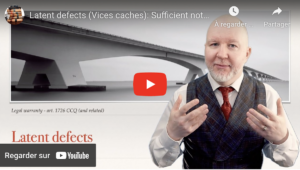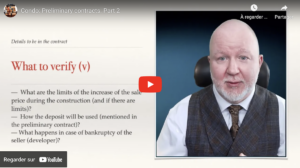
Buying an expensive thing second hand implies some risk, this is inevitable. Of course, a diligent buyer should have a look and verify what is reasonably possible. Yet, there is always a chance that a defect was hidden, latent. In Quebec this is commonly known as “vice caché.”
When it comes to real estate, such a latent defect might cost quite a lot to fix. This is not to mention that should the buyer have this knowledge before, the property price might go down significantly. Sometimes the works necessary might cost up to a third of the whole value of a house, for example. When the amount at stake is significant, a latent defect situation cries for a lawyer.
Latent or not latent? (Vice caché ou pas caché?)
Civil Code of Quebec provides a remedy for a latent defect, but it should be latent. If it was visible or could be visible in case of a diligent inspection, then it is assumed that the buyer knew (or should have known) and accepted the property as is. This also applies to situations where some clear traces of the defect were visible, but the buyer preferred not to investigate further.
Legal warranty by the Civil Code requires the seller to cover the cost of work to fix a defect that was not known at the time of purchase.
Of course, property might be sold without legal warranty (if the property buyer accepts that). In that case a truly latent defect (vice caché) is not covered. But there is still a case when the defect was known to the seller, but the buyer was not informed. Sometimes one can even find traces of certain cosmetic work aimed specifically at misleading a buyer coming for a visual inspection.
Common practice is to hire an inspector and then to rely on his report. If something clearly visible was missed in the report, the buyer’s claim might be against the inspector, not against the seller. Often the insurance company of the inspector gets involved then.
Time passed
Sure, the question of time passed is important. The later it comes to the buyer’s attention that some latent defect is present, the more it is possible that this defect appeared or at least got worse at the buyer’s watch. Here the responsibility would be shared with the seller, at the least. It is not inconceivable that the responsibility would be entirely attributed to the buyer even.
Similarly, a buyer might have discovered a situation of a latent defect (vice caché) but he waited a long time to inform the seller. This should play in favour of the seller and against the buyer.
Urgency
Finally, it might be that the repairs were not urgent (and urgency is to be proven), but the buyer preferred to contract workers on his own. This is instead of informing the seller and asking him to take care of a problem. The seller might then contest the amount paid. The argument would be that everything could be fixed at a significantly lower cost. (It is not unusual that a buyer, starting with necessary repairs, goes on with renovations. This is quite understandable from a commonsensical point of view, but aggravates the legal situation).
As you see, it is not enough to find that the property bought is defective. This is simply not enough to claim money from the seller. The questions are if the defect existed before the purchase and to what extent, if the seller knew of its existence, if the buyer could notice the defect (or some indication of it) by way of visual inspection, what is the time passed since the purchase and — always the most important question — what evidence exists to prove it all. If any significant amount of money is implicated in such a latent defect (vice caché) conflict, getting yourself a lawyer might be your best investment.
Allen Madelin Lawyers provide consultations and representation in real estate cases. In need, please contact us by phone: 1 514 904 4017 or by email: [email protected].



